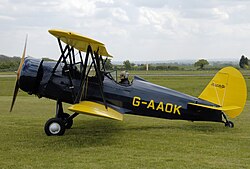Demise of aircraft production
Curtiss-Wright failed to make the transition to design and production of jet aircraft, despite several attempts. During the war, the company expended only small amounts on aircraft research and development, instead concentrating on incremental improvements in conventional aircraft already in wartime production. This was especially true in the first two years of the war. Curtiss' failure to research and develop more advanced wing and airframe designs provided an opening for North American, Bell, Lockheed, Northrop, and other U.S. aircraft manufacturers to win contracts from the Army and Navy for more advanced aircraft designs.
The P-60, the firm's last prop-driven fighter design, was merely an extrapolation of its 1930s P-36 Hawk, offering no advantage over other designs already in service. With the rapid development of jet engine technology and the advent of near-supersonic flight, this technological lag resulted in Curtiss losing several critical postwar military aircraft orders. The final nail in the coffin was the choice of the Northrop F-89 Scorpion over the XF-87 Blackhawk. After the F-87 was cancelled in October 1948, Curtiss-Wright shut down its entire Aeroplane Division and sold the assets to North American Aviation. Curtiss-Wright occasionally ventured back into the realm of aircraft design, as seen in the TDU-12/B Skydart target drone and the X-19 tiltrotor. Still, none of these efforts amounted to anything, and by the early 1960s, Curtiss-Wright was no longer a major aircraft manufacturer.
Business diversification and acquisition strategy
In 1956, financially strapped automaker Studebaker-Packard Corporation entered into a management agreement with Curtiss-Wright to allow the nation's fifth-largest automobile manufacturer to avoid insolvency. The relationship lasted until 1959, when Curtiss-Wright withdrew from the agreement. The shift of civilian aircraft to jets left the company with little of its old business, and during the 1960s it shifted to components for aircraft and other types of equipment, such as nuclear submarines, a business that continues today.
In 2002, Curtiss-Wright acquired Penny & Giles, a supplier of black boxes and sensing devices (Hybrid linear, hybrid rotary, and VRVT sensors). [15]
In 2003, Curtiss-Wright acquired Systran Corporation, a supplier of specialized data communications products for real-time systems, primarily serving the aerospace and defense, industrial automation, and medical imaging markets. [16] The acquisition also reintroduced Curtiss-Wright to Dayton, Ohio.
In 2010, Curtiss-Wright acquired Hybricon Corporation for $19 million in cash. Hybricon is a supplier of electronic packaging for the aerospace, defense, and commercial markets, providing electronic subsystem integration. [17]
In 2011, Curtiss-Wright acquired Ireland-based Acra Control for $61 million in cash. Acra Control is a supplier of data acquisition systems and networks, data recorders, and telemetry ground stations for both defense and commercial aerospace markets. [18]
At the beginning of 2013, Curtiss-Wright acquired Exlar Corporation for $85 million in cash. Exlar, a private company, is a designer and manufacturer of highly engineered electric actuators used in motion control solutions in industrial and military markets. The acquired business will operate within Curtiss-Wright's Motion Control segment. [19] In October 2013, Curtiss-Wright completed the acquisition of the Parvus Corporation, a business unit of Eurotech S.p.A., for $38 million. Parvus is a leading designer and manufacturer of rugged, small-form-factor computers and communications subsystems for the aerospace, defense, homeland security, and industrial markets. [20]
Curtiss-Wright acquired military communications equipment supplier Pacific Star Communications for $400 million, on November 2, 2020. [21] [22]
Curtiss-Wright Corporation finalized the acquisition of 901D Holdings, LLC (901D) for $132 million in cash. Designing and manufacturing electronic systems, subsystems, and shipboard enclosures, 901D is a contributor to major U.S. Navy shipbuilding programs, including both nuclear and non-nuclear powered vessels. [23]
In February 2020, Curtiss-Wright Corporation (NYSE: CW) completed the acquisition of Dyna-Flo Control Valve Services Ltd. ("Dyna-Flo") for $81 million in cash. [24]
In January 2022, Curtiss-Wright Corporation (CW) announced an agreement to acquire assets from Safran Aerosystems Arresting Company (SAA), a move aimed at expanding its presence in the military aircraft emergency arresting systems sector. SAA, a subsidiary of Safran Aerosystems, specializes in designing and manufacturing aircraft emergency arresting systems and will operate within Curtiss-Wright's Naval & Power segment following the acquisition. The completion of the acquisition, valued at $240 million, is contingent on regulatory approval and other closing conditions, with expectations for finalization in the third quarter of 2022. The strategic acquisition of SAA is part of Curtiss-Wright's efforts to enhance growth prospects and diversify its product portfolio. With an anticipated positive impact on CW's earnings, the $240 million transaction is projected to contribute to a robust free cash flow conversion rate exceeding 100%, signaling a favorable liquidity position for the company in the future. [25]
In November 2022, CW finalized the acquisition of Keronite Group Limited, involving a cash transaction of $35 million. This strategic move is expected to enhance Curtiss-Wright's capabilities in Plasma Electrolytic Oxidation ("PEO") surface treatment services. Operating within Curtiss-Wright's Aerospace & Industrial segment, the acquisition is projected to have a neutral impact on the company's earnings in the initial year. It is anticipated to yield a 100% free cash flow conversion rate, underscoring the robust liquidity position. This strengthened financial position can be leveraged for profitable and revenue-generating strategies. [26]



